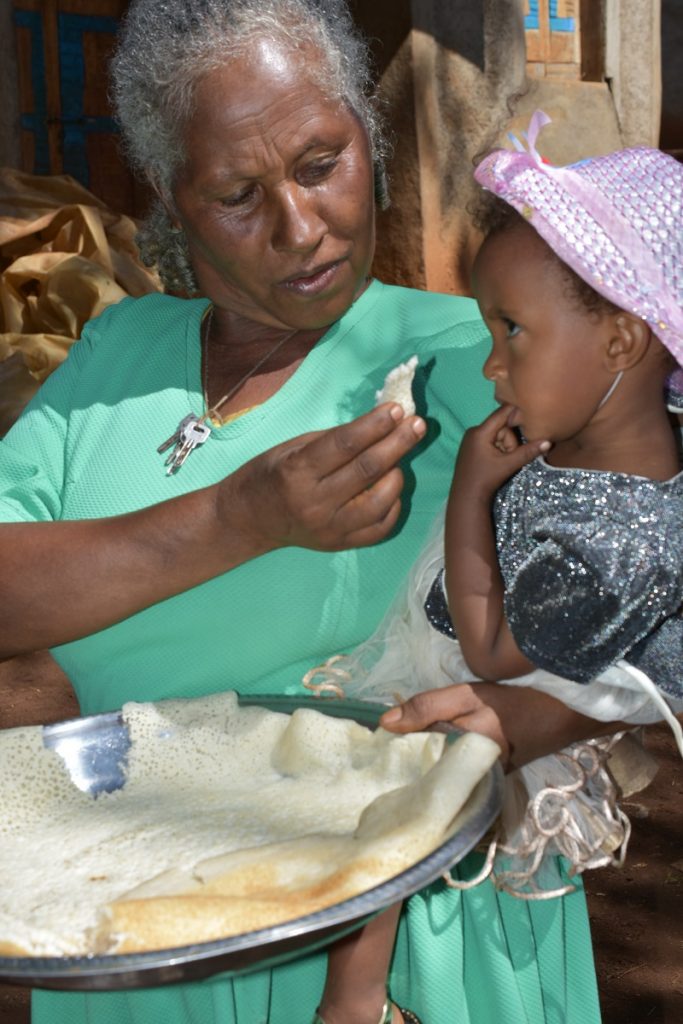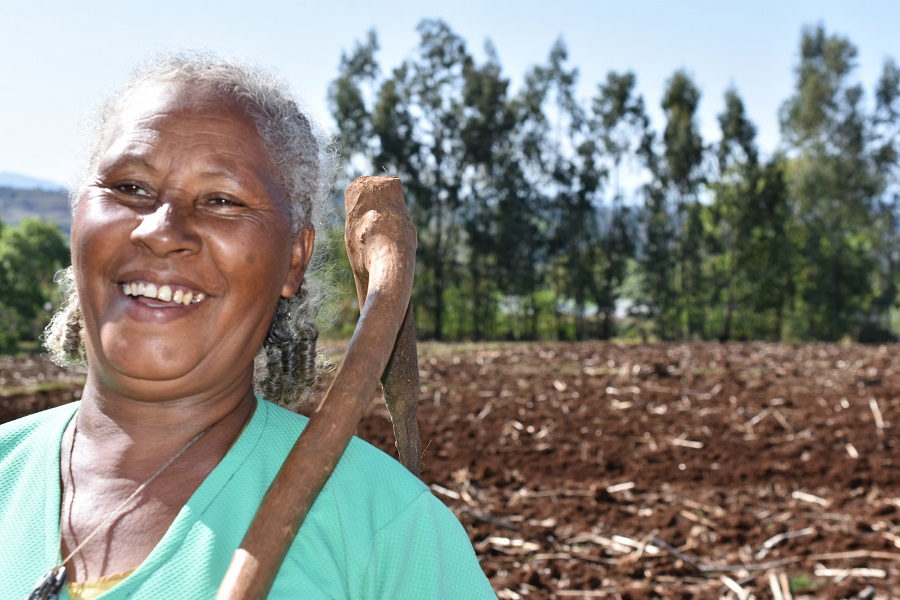Ethiopian maize farmers fast adopting new drought-tolerant maize hybrid to boost their productivity and resilience.
‘’Getting a good maize harvest every year, even when it does not rain much, is important for my family’s welfare’’ says Sequare Regassa, a widow and mother of four, while feeding her granddaughter with white injera, a rollable flatbread, made of white grain maize.

Since her husband died, Sequare has been for many years the only bread winner for her family. Her children have grown up and established their own families. The whole extended family makes a living from their eight-hectare farm in Guba Sayo district in Oromia Zone, Ethiopia.
On the two hectares Sequare cultivates on her own, she rotates maize with pepper, sweet potato and anchote, a local tuber similar to cassava. Like many farming families in the region, she primarily grows maize for household food consumption, prepared as bread, soup, porridge and snacks. Maize represents a third of cereals grown in Ethiopia. Cheaper than wheat or teff (a traditional millet grain in Ethiopia), maize is important for poor households as they mix maize flour with teff to make the national staple injera.
During a field visit in mid-April, Sequare was busy preparing the land for the next cropping season. She wondered if rains will be good this year as the onset of rainy season was quite late. Choice of maize variety could be crucial.
She used to plant a late maturing hybrid released more than 25 years ago, BH660, the most popular variety in the early 2000’s. However, this variety was not selected for drought tolerance. Ethiopian farmers face increasing drought risks, like the recent 2015 El Nino dry spell, severely impacting staple crop production, and leading to food insecurity and grain price volatility.
Convincing demonstrations for farmers and seed companies
Under the Drought Tolerant Maize for Africa (DTMA) project, maize breeders from the International Maize and Wheat Improvement Center (CIMMYT) and the Ethiopian Institute for Agricultural Research (EIAR) developed promising drought tolerant hybrids which perform well under drought and normal conditions. After a series of evaluations, BH661 emerged as the best candidate with 10% better on-farm grain yield, higher biomass production, shorter maturity and 34 percent reduction in lodging, compared to BH660. BH661 was released in 2011 for commercial cultivation in the mid-altitude sub-humid and transition highlands.
The year after, as farmers experienced drought, the Ethiopian extension service organized BH661 on-farm demonstrations, while EIAR and CIMMYT breeders organized Participatory Varietal Selection (PVS) trials. Farmers were impressed by the outstanding performances of BH661 during these demos and PVS trials and started asking for seeds immediately, forcing seed companies to quickly scale-up certified seed production of this new drought tolerant hybrid.
The Stress Tolerant Maize for Africa (STMA) team assisted local seed companies to switch to BH661 in a series of trainings and varietal trials. They were rapidly convinced as well to replace the old hybrid, BH660. ‘’In addition to drought tolerance, BH661 is more resistant to important maize diseases like Turcicum Leaf Blight and Grey Leaf Spot. For seed companies, there is no change in the way the hybrid is produced compared to BH660, but seed production of BH661 is much more cost-effective, ’’ explained Dagne Wegary, CIMMYT maize breeder.
The national Bako National Maize Research Center supplied breeder seeds to certified seed producers—namely, Amhara Seed Enterprise (ASE), Bako Agricultural Research Center (BARC), Ethiopian Seed Enterprise (ESE), Oromia Seed Enterprise (OSE) and South Seed Enterprise (SSE). Certified seeds were then distributed through seed companies’ own sales teams, agricultural offices, and non- governmental organizations, with the technical and extension support of research centers.
Weatherproof hybrid harvests additional incomes
After witnessing the performance of BH661 in a neighbor’s field, Sequare asked advice from her local extension officer, and decided to adopt this hybrid along with recommended agronomic practices. She is now able to produce between 11-12 tons per hectare. She said her family life has changed forever since she started planting BH661.

(credit: CIMMYT / Simret Yasabu)
‘’If farmers follow the recommended fertilizer application and other farming practices, BH661 performs much better than the old BH660 variety,’’ explained Sequare. “If we experience a drought, it may be not that bad thanks to BH 661’s drought tolerance,’’ she added. Sequare buys her improved seeds from Bako Research Station, as well as from farmers’ Cooperative Unions (FCU). The FCU access seeds from various seed companies and sell to farmers in their respective districts. ‘’Many around me are interested in growing BH661. Sometimes we may get less seeds than requested as the demand exceeds the supply.’’
With higher maize grain harvest, she is now able to better feed her chickens, sheep and cattle. She also sells some surplus to the local market to get some additional income, which she will spend on household necessities. Sequare observed that maize prices increased in recent years, with 100 kg bag of maize sold at ETB 600 – 700 ($20-23), while it had previously been sold between ETB 200 – 400 ($7-14). With the increased farmers’ wealth in her village, families were able to pay collectively for the installation of a communal water point to get easy access to clean water.
‘’Like women’s role in a society, no one can forget the role maize has in our community. It feeds us, it feeds our animals, cobs are used as fuel. A successful maize harvest every year is a boon for our village,’’ Sequare concluded.
Tags: BH661, drought tolerant maize, Ethiopia
Trackback from your site.
